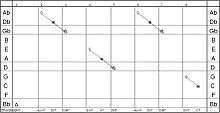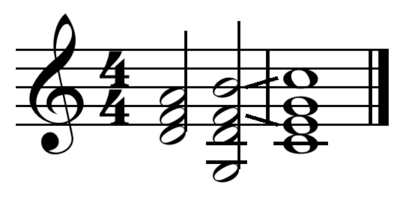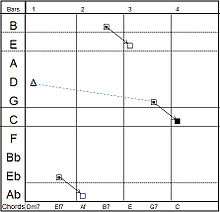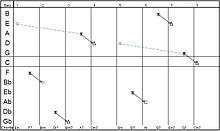Coltrane changes
In jazz harmony, the Coltrane changes (Coltrane Matrix or cycle, also known as chromatic third relations and multi-tonic changes) are a harmonic progression variation using substitute chords over common jazz chord progressions. These substitution patterns were first demonstrated by jazz musician John Coltrane on the albums Bags & Trane (on the track "Three Little Words") and Cannonball Adderley Quintet in Chicago (on "Limehouse Blues").[1] Coltrane continued his explorations on the 1960 album Giant Steps, and expanded upon the substitution cycle in his compositions "Giant Steps" and "Countdown", the latter of which is a reharmonized version of Eddie Vinson's "Tune Up." The Coltrane changes are a standard advanced harmonic substitution used in jazz improvisation.
The changes serve as a pattern of chord substitutions for the ii-V-I progression (supertonic-dominant-tonic) ![]() Play and are noted for the tonally unusual root movement by major thirds (either up or down by a major third interval as opposed to more typical minor or major seconds intervals, see steps and skips, thus "Giant Steps"), creating an augmented triad.
Play and are noted for the tonally unusual root movement by major thirds (either up or down by a major third interval as opposed to more typical minor or major seconds intervals, see steps and skips, thus "Giant Steps"), creating an augmented triad.
Influences
David Demsey,[2] saxophonist and Coordinator of Jazz Studies at William Paterson University, cites a number of influences leading toward's Coltrane's development of these changes. After Coltrane's death it was proposed that his "preoccupation with... chromatic third-relations" was inspired by religion or spirituality, with three equal key areas having numerological significance representing a "'magic triangle,'" or, "the trinity, God, or unity."[3] However, as seen above, Demsey shows that though this meaning was of some importance, third relationships were much more "earthly," or rather historical, in origin. Mention should be made of his interests in Indian ragas during the early 1960s, the Trimurti of Vishnu, Brahma and Shiva may well have been an inherent reference in his chromatic third relations, tritone substitutes et al.[3]
Miles Davis, who mentored Coltrane in many ways, was in the late 1950s moving toward the modal style demonstrated on Kind of Blue. In playing that style, Coltrane found it "easy to apply the harmonic ideas I had... I started experimenting because I was striving for more individual development."[4] He developed his sheets of sound style while playing with Davis and with pianist Thelonious Monk during this period.[5] It should be noted that saxophonist Odean Pope credits pianist Hasaan Ibn Ali as having been a major influence on Coltrane in his development of the so-called sheets of sound style.[6]
Coltrane studied harmony with Dennis Sandole and at the Granoff School of Music in Philadelphia. He explored contemporary techniques and theory. He also studied the Thesaurus of Scales and Melodic Patterns by Nicolas Slonimsky (1947),[7] which additionally served as practice material. The first half of Giant Steps (melody and harmony) is contained in the Preface of Slonimsky's book.

The bridge of the Rodgers and Hart song and jazz standard "Have You Met Miss Jones?" (1937) predated Tadd Dameron's "Lady Bird", after which Coltrane named his "Lazy Bird", by incorporating modulation by major third(s).[8] (shown by the * below) "Giant Steps" and "Countdown" may both have taken the inspiration for their augmented tonal cycles from "Have You Met Miss Jones?".[9]
- "Have You Met Miss Jones?" B section chord progression (Bridge):
| * | | * | | * | | * | || | BbM7 | Abm7 Db7 | GbM7 | Em7 A7 | DM7 | Abm7 Db7 | GbM7 | Gm7 C7 ||
 |
Play the chord progression for the "Have You Met Miss Jones?" bridge section
|
| Problems playing this file? See media help. | |
Coltrane substitution

The Coltrane substitution, Coltrane changes, or "'Countdown' formula" is as follows. Given the II-V-I turnaround lasting four measures:
II7 | V7 | I | I || Dm7 | G7 | C | C ||
with the dominant chord (V7) preceding the tonic (I).

One substitutes two chords for each of the first three:
II7 | | V7 | I || Dm7 Eb7 | Ab B7 | E G7 | C || m2 P4 m3 P4 m3 P4[10]
Notice a dominant seventh chord preceding and thus tonicizing a major chord on C and also E and Ab, both a major third from C.
(V7 | I)(V7 | I)(V7 | I) Eb7 | Ab B7 | E G7 | C

This also may begin on C, as on "Giant Steps", giving:
C Eb7 | Ab B7 | E G7 | C || m3 P4 m3 P4 m3 P4[10]
The major thirds cycle
The harmonic use of the chromatic third relation originated in the Romantic era and may occur on any structural level, for example in chord progressions or through key changes.[11] The standard Western chromatic scale has twelve equidistant semitones.[12] When arranged according to the circle of fifths, it looks like this:

Precisely because of this equidistancy, the roots of these three chords can produce a destabilizing effect; if C, A-flat, and E appear as the tonic pitches of three key areas on a larger level, the identity of the composition's tonal center can only be determined by the closure of the composition.— Demsey (1991)[11]
Looking above at the marked chords from "Have You Met Miss Jones?", B♭-G♭-D are spaced a major third apart. On the circle of fifths it appears as an equilateral triangle:

By rotating the triangle, all of the thirds cycles can be shown. Note that there are only four unique thirds cycles. This approach can be generalized; different interval cycles will appear as different polygons on the diagram.
"Tune Up" and "Countdown"

 |
Play this "Tune Up" excerpt chord progression
|
| Problems playing this file? See media help. | |
"Tune Up"
These are the first eight bars of the Miles Davis composition "Tune Up". The chord changes are relatively simple, a straightforward application of the II-V-I progression, which is extremely common in jazz.
| II | V | I | I | II | V | I | I || | Em7 | A7 | DM7 | DM7 | Dm7 | G7 | CM7 | CM7 ||
The chord progression is a standard II7 V7 I progression in D Major and then in C Major. Assume that the time signature is 4/4 and that each II and V chord gets 4 beats and the I chord gets 8 beats.
"Countdown"
The Changes below show Coltrane's substitution of chord changes over "Tune Up". When writing jazz tunes that substitute chords, it is very common to title the tune with a play on words of the name of the original composition, hence "Tune Up" became "Countdown". The ii V I progression from "Tune Up" still appears but is enhanced with several transition chords that lead to a more complex harmonic progression.
| ii | * | * V | I* | ii | * | * V | I* || | Em7 F7 | BbM7 Db7 | GbM7 A7 | DM7 | Dm7 Eb7 | AbM7 B7 | EM7 G7 | CM7 ||

 |
Play this "Countdown" excerpt chord progression
|
| Problems playing this file? See media help. | |
In the standard Coltrane change cycle the ii V I is substituted with a progression of chords that cycle back to the V I at the end. In a 4/4 piece, each chord gets 2 beats per change.
Coltrane developed this modified chord progression for "Countdown", which is much more complex. At its core, "Countdown" is a variation of "Tune Up", but the harmonic substitutions occur rapidly and trick the listener into thinking that they are listening to a completely unrelated tune. The ii, V and I remain, but in between are other chords(*) from the major thirds cycle centered around each I . Preceding the first chord of each major thirds cycle is its V chord.
An earlier Coltrane piece, "Lazy Bird", also features two tonal centers a major third apart in its A section.
"Giant Steps"
The Giant Steps cycle is the culmination of Coltrane's theories applied to a completely new chord progression: Coltrane uses the Coltrane cycle in descending Major 3rd tonal transpositions in the opening bars and then ascending ii V I progressions separated by a major 3rd in the second section of Giant Steps. The second section is basically the inverse of the bridge section described in "Have You Met Miss Jones" above.
| I Coltrane Substitution Cycle| ii V | I Coltrane Substitution Cycle| | BM7* D7 | GM7* Bb7 | EbM7* | Am7 D7 | GM7* Bb7 | EbM7* F#7 | BM7* |
Ascending/Descending ii V I progression separated by a Major 3rd (Tonal centers E♭ - G - B - E♭ - B)
| ii V | I | ii V | I | ii V | I | ii V | I | ii V :|| | Fm7 Bb7 | EbM7* | Am7 D7 | GM7* | C#m7 F#7 | BM7* | Fm7 Bb7 | EbM7* | C#m7 F#7 :||

This diagram shows what scales are used for the different chords:
- BMaj7
- B Maj scale
- D7 to GMaj7
- G Maj scale
- B♭7 to E♭Maj7
- Eb Maj scale
- Am7 to D7 to Gmaj7
- G Maj scale
- B♭7 to E♭Maj7
- Eb Maj scale
- F♯7 to BMaj7
- B Maj scale
- Fm7 to B♭7 to E♭Maj7
- Eb Maj scale
- Am7 to D7 to GMaj7
- G Maj scale
- C♯m7 to F♯7 to BMaj7
- B Maj scale
- Fm7 to Bb7 to E♭Maj7
- Eb Maj scale
- C♯m7 to F♯7
- B Maj scale
The standard substitution
Although "Giant Steps" and "Countdown" are perhaps the most famous examples, both of these compositions use slight variants of the standard Coltrane changes (The first eight bars of "Giant Steps" uses a shortened version that doesn't return to the "I" chord, and in "Countdown" the progression begins on the IIm7 each time.). The standard substitution can be found in several Coltrane compositions and arrangements all recorded around this time. These include: "26-2" (a re-harmonization of Charlie Parker's "Confirmation"), "Satellite" (based on the standard "How High the Moon"), the tune "Exotica" (loosely based on the harmonic form of "I Can't Get Started"), Coltrane's arrangement of the standard "But Not for Me," and on the bridge of his arrangement of the famous ballad "Body and Soul."
In addition, Coltrane's tune "Fifth House" (based on "What is This Thing Called Love") is particularly notable because the standard substitution is implied over an ostinato bass pattern, with nobody actually playing the chord changes. When Coltrane's improvisation superimposes this progression over the ostinato bass, it is easy to hear how he used this concept for his more free playing in later years.
See also
Further reading
- Baker, David N. (1990). The Jazz Style of John Coltrane. Alfred Publishing. ISBN 0-7692-3326-0.
- Nettles, Barrie & Graf, Richard (1997). The Chord Scale Theory and Jazz Harmony. Advance Music, ISBN 3-89221-056-X.
- Weiskopf, Walt; Ray Ricker (1991). Coltrane - A Player's Guide to His Harmony. New Albany, Indiana: Jamey Aebersold.
- Yamaguchi, Masaya (2002). "A Creative Approach to Multi-Tonic Changes: Beyond Coltrane's Harmonic Formula", Annual Review of Jazz Studies 12. ISBN 0-8108-5005-2.
- Yamaguchi, Masaya (2003). John Coltrane Plays Coltrane Changes. Milwaukee: Hal Leonard Corp. ISBN 0-634-03864-8.
References
- ↑ Porter, Lewis (January 28, 2000). John Coltrane: His Life and Music. Ann Arbor, Michigan: University of Michigan Press. p. 151. ISBN 978-0-472-08643-6.
- ↑ Demsey, David (1996). John Coltrane Plays Giant Steps. Milwaukee: Hal Leonard Corp. ISBN 0-7935-6345-3.
- 1 2 Demsey (1991), p.145.
- ↑ Demsey, David (1991). “Chromatic Third Relations in the Music of John Coltrane,”, p.158, Annual Review of Jazz Studies 5: 145-80. ISBN 0-8108-2478-7.
- ↑ Ruhlmann, William. "John Coltrane Biography", allmusic.com.
- ↑ Porter, Lewis; DeVito, Chris; WIld, David; Fujioka, Yasuhiro; Schmaler, Wolf (2007). The John Coltrane Reference. The book cites Cadence, February 1989, pages 6-7, interview of Odean Pope by Ludwig Van Trikt from September 7, 1987. London: Routledge. pp. unnumbered page in section 1955 Chronology, sub–section Hasaan, Trane, and Odean Pope. ISBN 978-0415977555.
- ↑ Porter, Lewis (January 28, 2000). John Coltrane: His Life and Music. Ann Arbor, Michigan: University of Michigan Press. p. 149. ISBN 978-0-472-08643-6.
- ↑ Lyon, Jason (2007). "Coltrane's Substitution Tunes", in www.opus28.co.uk/jazzarticles.html.
- ↑ Christiansen, Corey (2007). "Coltrane-Style II-V-Is", Guitar Player Jun; 41, 6.
- 1 2 Baker, David (1990). Modern Concepts in Jazz Improvisation, p.92-93. ISBN 0-7390-2907-X.
- 1 2 Demsey (1991), p.146-147.
- ↑ Proctor, Gregory (1978). Nineteenth-Century Chromatic Tonality: A Study in Chromaticism, p.150. Ph.D., Diss., Princeton. Cited in Demsey (1991), p.148.
External links
- "The Giant Steps Progression and Cycle Diagrams", DanAdler.com (155 KB PDF) - Dan Adler
- "John Coltrane - Harmonic Substitutions", LucasPickford.com: "Extending the Coltrane Changes" by David Baker
- "Giant Steps (in minute detail)", SongTrellis.
- Javier Arau. "Augmented Scale Theory", Javier Arau.
- Michael Leibson. "Giant Steps, Central Park West and Modulatory Cycles", ThinkingMusic.ca.